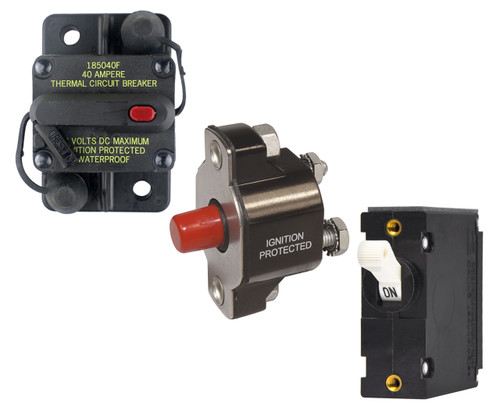Categories
- Wire & Cable
- Multi-conductor & Signal Cable
- Battery Cable Assemblies
- Terminals and Connectors
- Electrical Parts
- Electrical Tools
- ID Products
- Wire Management
- Tape & Sealant
- Mounting Panels & Panel Blanks

Need Help?
Click HereGet a Business Account
Apply HereElectrical Parts

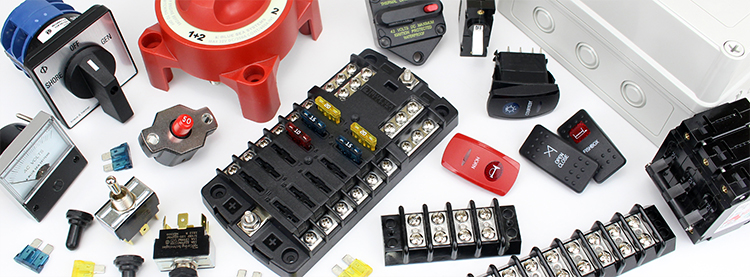
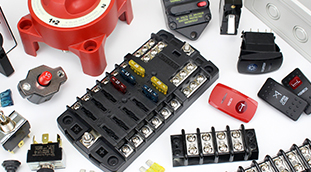
What are electrical parts?
Electrical parts are any number of pieces equipment, either internal or external, that operate as part of an electrical system in a way that can be modified. These could include electrical components or electrical products such as; breakers, switches, lights, meters, bus bars, batteries, chargers, or any of a number of electrical supplies. So, you may be asking, why aren’t terminals electrical parts? Terminals are like wire or cable in that they don’t have moving parts or perform a function outside of carrying electrical current and making a connection. When we use the term electrical parts, it is meant to intend the functional pieces of your electrical system. A switch can be turned on or off. A breaker can be flipped. A meter can fluctuate. Basically, if it’s a part of your vehicles electrical system, and can be manipulated in some form, then we consider it an electrical part.
"When we use the term electrical parts, it is meant to intend the functional pieces of your electrical system."

Switches

Switch Covers

Breakers

Breaker Accessories

Terminal Blocks

Bus Bars

Fuses and Fuse Blocks

Meters

Battery Management

Enclosures and Boxes
Where are electrical parts implemented?
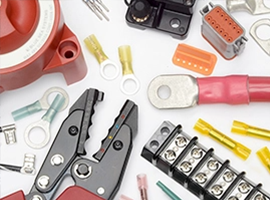
The term Electrical Parts covers a wide range of products
Electrical parts are implemented in just about every marine application that you can think of. From switches and switch covers to bus bars and enclosures, they are designed to cover a wide range of applications. They are ideal for new installations as well as for use as replacement parts. Suppose you have a dead bulb on your rocker switch, then check our new switch bodies. Maybe your switch covers are faded. Well, a simple solution is to look at our new switch covers. Now you have a basic idea of where these products are implemented so let us take a look at the best way to figure out which part is right for your application.
How do I know what I’m looking for?
Finding the right electrical components to complete your project is not always an easy task. We placed all our electrical parts into convenient categories in order to make finding the right part as easy as possible. Sometimes you may not know which type of switch or breaker will work best in a given situation. We’ve done our best to answer some of the most common questions we receive from our customers. Our hope is that this information helps you in choosing the right electrical part for your project. Take a quick look below as we give a brief description of each style of electrical part we carry.
![]() Switches
Switches
A crucial part of any electrical system. The simplest method of turning something on and off, but our switches go further than that. Some of our switches let you select which battery to pull from, or whether you want to run a generator or pull from shore power. Maybe you want to look at multiple position toggle switches. You’ll find that switches can be much more than just on and off.
![]() Switch Covers
Switch Covers
What good are switches if no one knows what they do? Rocker switches are usually found on panels, but they can be elsewhere as well. When you have several switches in a row, the best way to tell them apart is with text and a visual indicator. We have surpassed the competition when it comes to cover options, but we will talk more about that further down.
![]() Breakers
Breakers
Any electrical system is vulnerable to spikes in power which can destroy expensive equipment. Think of a breaker as an intentional weak link in an electrical system. This weak link breaks contact when the power is too much and before the power can reach that expensive equipment. This type of electrical component is essential in an electrical system. They are actually quite similar to fuses except they are meant for repeated use and don’t need to be replaced each time you operate them.
![]() Breaker Accessories
Breaker Accessories
Accessories are often meant to enhance the functionality of electrical products. This can be in a variety of ways, some of which are meant to increase its lifespan or give it better resistance to its environment. Many types of electrical supplies can be considered accessories. Sometimes accessories are meant to increase the safety of a given product making them an invaluable resource. Whether you add something to extend the life of a product or to give it more options, accessories can be extremely useful.
![]() Terminal Blocks
Terminal Blocks
These can be considered wire hubs. Basically, it’s a modular block with separated circuits in a row. The body itself is insulated for safety and can be easily mounted. Then, you simply run your wires to one convenient spot. It makes a wiring system cleaner and easier to navigate. These are one of many types of electrical supplies that can increase the functionality of your electrical system.
![]() Bus Bars
Bus Bars
Consolidating positive wires or negative wires in one place is an easy task with bus bars. They are used as an easy, convenient way to distribute power, as a proper ground. Either way, they have an insulated body and are built from tin plated copper which prevents corrosion and increases conductivity. As far as electrical products go, these are useful, efficient, and easy to use.
![]() Fuses
Fuses
Fuses are electrical components designed to protect electrical systems. Similar to breakers, they are an intentional weak point designed to protect equipment from power surges. Even though fuses have to be replaced each time, they take up much less space than a breaker would. When the available surface area is limited, fuses are the smart choice.
![]() Meters
Meters
Nearly everything an electrical system is doing is hidden from the human eye. We can’t detect voltage, amperage, or temperature naturally, but meters can. They allow us to clearly see exactly how our electrical system is performing and be preemptive if an issue arises. When considering electrical supplies size is a factor. Most of the meters we carry are small in order to take up as little space as possible.
![]() Battery Management
Battery Management
Batteries are necessary for any electrical system, giving it the needed power to get going. Managing your batteries is an essential task that we aim to make easier. Chargers, switches, and solenoids are all a way to make your battery system more efficient. This can lead to saving money and time or even getting a longer life out of your batteries. These are undoubtedly one of the most important electrical products you'll need.
![]() Indicator Lights
Indicator Lights
Finding an issue as it arises is a surefire way to protect the life of your electrical system. Using the proper electrical supplies and electrical products will give you an advantage. Indicator lights are used to notify you of an issue. They are designed to light up at the first sign of trouble. We offer different colors so that you can connect them to varying systems and monitor several areas at once. When choosing the correct electrical components for your vessel, consider indicator lights.
Protecting your electrical parts from harsh environments will extend their life. Enclosures protect your electrical components from; chemicals, water, dust, oil, and more. They contain gaskets to make them waterproof. This way when you mount your sensitive equipment in one of our enclosures or junction boxes, you know that they are safe. They are built to protect electrical products from damage due to weather and other hazards.
What type of switches are available?
Switches are a category of electrical products that come in a variety of styles to meet the demands of different tasks. As I stated above, they can be much more than just the old “on-off” idea. Switches, in fact, can have quite a few different purposes. Some are multi-position while others are only momentary position. Some will switch between battery banks or even combine those banks into one. It really depends on what you’re trying to accomplish in order to know which type of switch you need. In this way, you can find what you need to finish your project ahead of schedule. As far as electrical supplies are concerned, switches are essential. Let’s take a quick glance at some of the most popular types of switches that we carry.
![]()
Rocker Switches
![]()
Bat Toggle Switches
![]()
Battery Switches
![]()
Power Transfer Switches
Rocker Switches - This type of switch is designed for ease of access and use with visually appealing switch covers. They commonly go in high visibility areas and are used to access heavily used equipment be it, lights, trim, pumps, radio, or more. You get the point. These are the switches people tend to interact with the most and as such, need to have a high level of visual quality in their switch covers. They are a very common choice when customers are choosing electrical products to enhance the appearance of their boat. These switches can be momentary for things like a horn or multi-step for things like trim control.
Bat Toggle - These electrical supplies are used for simple power control in most instances. Again, they can be more than just on or off. Bat toggle switches can be single pole or double pole. They also offer the option for momentary contact depending on the intended use of the switch. One thing to consider is the environment where you will place them. If they are going to be in harsh conditions, consider using a protective boot.
Battery Switches - Many boats require multiple batteries to be on board but do not need those batteries for all applications. Using electrical components such as battery switches allows you to select between battery banks, or in some cases, combine those banks. This is the simplest method to get the most out of your battery system. Most of our battery switches can be panel or surface mounted giving you more options on how to install them.
Power Transfer Switches - A lot of boats are designed to run off of generator power while out on the water but who wants to use a generator when at the dock? No one. That’s who. Why not connect to shore power? In order to do that you need electrical products such as power transfer switches. Quickly and easily switch from generator power to shore power when docked and save your generator for when you need it.
How many switch covers are available?
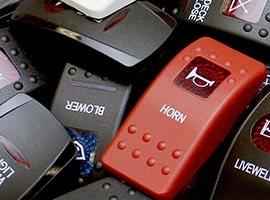
When it comes to choice, no one has us beat. We currently offer nearly 1,000 switch cover options and are about to increase that by another 3,000. You read that right. We are on our way to offering over 4,000 switch cover options. Switch covers are electrical components that offer one of the easiest ways to enhance the visual appearance of your panels. They allow you to customize the color, shape, number of lenses, print style, and more in order to get exactly what you’re looking for. As an added bonus, they are UV resistant and built to handle the harshest marine environment.
"Switch covers are electrical components that offer one of the easiest ways to enhance the visual appearance of your panels."
What is the right breaker for my project?
When selecting electrical supplies like breakers, the first thing to do is determine where you will be using the breaker and what the exact application will be. If the temperature is going to be an issue, use thermal breakers to avoid any complications that could arise. Magnetic breakers are more the durable choice so consider the direct application in relation to the environment. Another thing to consider is the overall size of the space that the breaker will occupy. Thermal breakers are the better choice if your space is limited as they have a small footprint when it comes to size.
![]()
Thermal Breakers
![]()
Magnetic Breakers
![]()
Marine Rated Breakers
Thermal breakers - This style of breaker is designed to “trip” when the heat increases beyond a specific threshold. Basically, the current running through the breaker generates heat. A certain amount of heat is expected. When the current is too high, the heat increases causing the breaker to trip, cutting off the power. These are often a superior choice to fuses as they don’t have to be replaced but rather reset.
Magnetic breakers - These breakers are designed for industrial and marine use and are not affected by temperature in the same way that thermal breakers or fuses are. They are the low-cost answer to power switching and reliable circuit protection. They are built to trip on overload protecting your electrical system. As an advanced safety feature, these breakers cannot be forcibly held on making them some of the safest electrical supplies you can own.
Marine Rated breakers - Typically, these electrical components are used in auxiliary or accessory circuits. Similar to magnetic breakers, this style of breaker cannot be forcibly held on. They are designed to be weatherproof and offer a visual manual reset switch meaning you can see if they have flipped without having to be in close proximity to the breaker itself. These types of electrical products enhance the functionality and safety of your boat.
Do I want terminal blocks or bus bars?
Often times the difference between electrical supplies such as bus bars and terminal blocks can confuse people who are unfamiliar with them. Although they do share some similarities, the differences between them are quite obvious when you take a good look at them. All you really need to know to decide which one you need is that terminals blocks are individually isolated circuits that will not overlap without the use of jumpers whereas bus bars handle one continuous circuit.
![]()
![]()
Terminal blocks - If you want to have all your wires organized in a clean, effective way yet still be separate circuits, you’ll want to use a terminal block. Basically, it’s like a bunch of splices where each circuit connects to the same hub. If you want to connect two or more circuits, you can use jumpers. Although they look similar to bus bars, terminal blocks are quite different. Be sure to know the difference when selecting the electrical supplies that are right for your project.
Bus Bars - If you want all your wires to be connected together in a single circuit, you definitely want to use a bus bar. Whereas a terminal block is made of isolated circuits, a bus bar is one continuous circuit. Again, this acts like a hub where power can be distributed to multiple devices. Bus bars come in a variety of sizes and styles in order to handle an equally wide range of applications. When choosing your electrical components, make sure they met the needs of your project.
What style of fuses do we carry?
As we said before, breakers and fuses are electrical products designed as intentional weak points in an electrical system. This is so a surge will not reach expensive or important equipment. The way they work is that as a surge travels through the fuse, the power is too much, and the fuse essentially breaks which cuts off the power. A variety of fuses are produced to handle different applications. Let’s take a look at some of the more common types of fuses we carry.
All glass cartridge” fuses have been used by the automotive industry for decades although they have been superseded in some ways by the ATO/ATC fuses. These fuses are fast acting which means that they offer maximum protection. One benefit of AGC fuses is that they offer wide volt/amp ratings which allow for versatility when protecting circuits.
These are the common blade type fuses you often find in modern cars and equipment. These electrical components are designed using a color coding and labeling system so that the amperage can quickly and easily be identified. They deliver fast-acting protection to a circuit and are made to be corrosion resistant.
Similar to ATO/ATC fuses, maxi fuses are color coded to make identification easy. Don’t worry about confusing them for one another as the maxi fuses are visibly much larger in size than ATO/ATC fuses. This type of fuse is used when high amperage circuit protection is required.
As the name implies, these electrical products are fuses that are used in battery circuit protection. They must be used in conjunction with a terminal fuse block which connects them directly to the battery post itself. These are often used for their small size and ease of access. These type of electrical supplies are a space-saving option with a clear window making visual indication of a blown fuse easy to see.
This type of fuse is designed for fast acting, current limiting protection. Their small size means that a benefit of their use is saving space. Class T fuses offer high interrupt capacity for battery banks and are even used with inverters. One of the biggest benefits of this type of fuse is that they offer extremely fast short circuit protection.
Which type of meter is right for my project?
Meters are electrical components that offer the easiest way to monitor your electrical system and stay ahead of problematic situations. Many of our meters can be panel mounted or surface mounted giving you a choice when it comes to appearance. The first thing to think about is whether you want an analog or digital display. There are clear advantages to both, so it really boils down to preference. When choosing the right meter, decide what it is you’re trying to measure. We offer voltmeters, ammeters, and temperature gauges in a variety of styles.
![]()
![]()
![]()
Ammeters - This type of meter is used to measure electric current in amperes. So just like the voltmeter, the ammeter does what its name implies. You’ll find that these meters are far more useful than people give them credit for.
Voltmeters - This is pretty straight forward. Voltmeters measure, you guessed it, voltage. They are designed to measure the electric potential in volts and display that information in an easy to read meter whether that be analog or digital.
Temperature Gauges - Ok, this is the last obvious one I’ll throw at you. These gauges are used to monitor the temperature of your electrical system, specifically your engine. These electrical components are meters that are waterproof and easy to read. Better yet, they are small meaning they take up little space and they are easy to install.
"Meters are electrical components that offer the easiest way to monitor your electrical system and stay ahead of problematic situations."
What types of battery management are available?
Battery management is crucial in a marine electrical system. This can include electrical supplies like battery chargers, solenoids, battery switches, or even USB chargers. Basically, anything that helps to maintain or prolong the life of your batteries will be found here. You’ll find that all our battery management parts are built with the harsh marine environment in mind. Our electrical products such as battery switches come in a variety of styles. Battery switches can be used to switch between, or in some cases, even combine battery banks. The battery chargers that we offer are based around the amperage required so make sure you consider your exact needs.

Now that you have a good idea of the battery management parts we offer, selecting the right electrical products should be a simple task. Remember, always carefully consider the direct application of the part you are considering and as always if you have a question, reach out to a Pacer Expert.
How do I select the right indicator lights?
Indicator lights are electrical products that are used to let you know when there is an issue in your electrical system. We offer indicator lights in several colors so that identification of the problem can be easier to identify. Each indicator light can be easily installed and is designed to withstand the toughest conditions. We carry the E3L series as well as the E5S series. The main difference between these lights is that the E3L series are white and snap-fit into a 5/16” hole and are secured with a spring clip. The E5S series is black and snap fits into a 1/2” hole, securing themselves with self-locking ears. Both series are available in a variety of colors such as red, green, blue, or amber so that you can isolate the problem even faster.
Which size of enclosure is ideal for my project?
Enclosures are electrical supplies that offer the ideal way to protect your electrical components. They are built to be wind, dust, chemical, and water resistant. Additionally, they are made from fiberglass, and as such, are flame resistant. Often times sensitive equipment needs to be protected from the harsh marine environment. This is when you would use electrical products like an enclosure. The maximum protection for durability and longevity. As I said above, they are flame resistant, so they are commonly used in places where the potential for fire breaking out is higher than normal. Any way you look at it, enclosures are a safe investment.

Now that you have an idea of the benefits behind enclosures let’s talk quickly about junction boxes. For the most part, the two names, junction box, and enclosure are synonymous. There are some differences, but the main one is their size. Junction boxes run the smaller end of the spectrum and enclosures run the larger end. Basically, right around six inches in length or width is the point of separation where you go from junction box to enclosure. Hopefully, this makes selecting the correct type easier for you. Remember, if you have any questions, reach out to a Pacer Expert.
Why choose Pacer?
We have spent decades building a name that you can trust. We offer the electrical solutions that some of the world’s largest boat builders turn to. Electrical parts and electrical components aren’t just types of electrical supplies we handle, they are the electrical supplies we use in our own boats. Products we have tested and the products we trust. With nearly forty years of experience, we have learned what it takes to make a good product and what it takes to handle the harshest marine environments the seas can throw at us. When you see Pacer, you know you’ve got a product you can trust.
*This page was updated on 2/08/2023*



